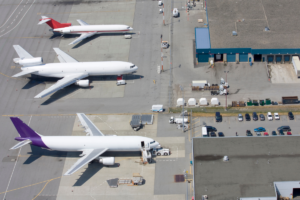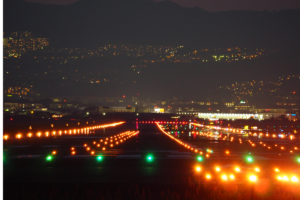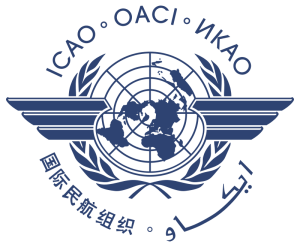The airport lighting industry has vastly improved the operations of airfields around the world thanks to advanced technology that enhances safety and efficiency on the runway and taxiway. Since the early days of using Tungsten-Halogen incandescent lamps to provide guidance to pilots, our industry has grown in leaps and bounds in terms of innovation.
However, given the milestones aviation has achieved over the past century, many airport experts agree that few advancements have improved runway safety like LED technology.
A Brief History Of Airport Lighting
Tungsten-halogen lamps were the industry standard for runway applications when our industry was in its infancy. Although they provided consistent light output, the beam’s intensity was impacted by temperature fluctuations and heavy precipitation. They also had very short lifespans, required frequent maintenance, and consumed energy inefficiently.
It wasn’t until several decades later that quartz-halogen lamps made their way into our runway lighting systems. These lights were noticeably brighter and provided improved guidance for pilots, but they still required frequent maintenance and used much more energy than incandescent lamps.
LEDs largely came onto the scene in the early 2000s, paving the way for mass adoption by airports around the world. The many benefits they bring to air traffic management and control have revolutionized our industry, making LEDs the acceptable industry standard for maximum safety, efficiency, and durability on the tarmac.
Read More: About Airport Lighting Company
How Did LEDs Revolutionize Airport Runway Operations?
Simply put, LED bulbs answered the airport industry’s need for enhanced energy efficiency and reliable performance in its runway lighting systems. They offer airport operators numerous benefits and advantages, such as:
Longer Lifespan
LED bulbs last longer than their predecessors, providing reliable service for as many as 100,000 hours, nearly 20 times longer than incandescent bulbs. Not only does this save airport operators money with fewer replacements, but it also saves time with technical personnel making fewer trips into the field to carry out the work.
Increased Energy Efficiency
LED technology consumes up to 70% less energy than traditional incandescent or halogen bulbs. With many airports operating expansive lighting systems 24/7, this translates to significant savings in operational costs.
Reliable Visibility Under All Conditions
Visibility is critical for pilots to make smooth landings, even in low-light conditions or inclement weather. LED technology really shines through with a uniform and intense output that enhances visibility even in adverse conditions such as fog, rain, or snow. They also reach full brightness immediately upon activation, enhancing safety when a fast response time is critical.
Advanced Color Variation
Airport operators can easily implement specific color-coded lighting schemes to enhance airport operations. For example, blue lights can be used to guide aircraft along the taxiway, yellow to indicate the landing threshold, and red to signal the end of a runway as an aircraft lands.
Integration With Adaptive systems
LED bulbs can integrate with an airport’s adaptive lighting system, which uses sensors and smart controls to dynamically control lighting intensity based on weather conditions, visibility levels, or aircraft movement. They can even be programmed to dim during periods of reduced activity to conserve energy.
Centralized Monitoring And Control
Many modern airports use monitoring and control systems to manage their runway and taxiway lighting network from a centralized location. LED lights can be easily integrated into these systems, allowing efficient scheduling of lighting operations, real-time lighting status updates, fault detection alerts, and other capabilities that assist air traffic controllers and airport operations personnel.
Read More: Improve Airport Operations With Remote Monitoring And Control Solutions
Supports Airport Sustainability Initiatives
Many airports are looking at ways to improve sustainability, and LED technology helps by offering several environmental benefits. For example, LEDs don’t need to be replaced as often, reducing the strain on landfill sites. LEDs also require less electricity to operate than other types of bulbs, decreasing carbon emissions associated with power consumption. Additionally, LEDs offer targeted illumination that directs light only where it’s needed, reducing light pollution that can impact nocturnal wildlife and the quality of life in local communities.
Connect With Advanced LED Technology With Airport Lighting Company
The team of engineering experts at Airport Lighting Company understands your need for tech-based solutions that will improve safety, enhance efficiencies, and cut costs. That’s why we work closely with our customers to ensure they have an airport lighting solution that meets their needs today and into the future.
Our products meet all the standards set by governing bodies such as the FAA, ICAO, and TP312 and are ETL-certified through third-party testing to ensure safe, reliable, and efficient performance. We also put each product through a multi-step quality control process, including hours of testing before we place a certification label on the item.
When you’re ready for a reliable airport lighting solution that meets your specific requirements, call our team for reliable products and services.
Call Airport Lighting Company For The Latest In Airport Lighting Technology
The Airport Lighting Company team is standing by to answer your questions about how our tech-based products can help improve the safety, reliability, and efficiency of your runways. Call 315-682-6460 for fast, friendly service you can count on.





